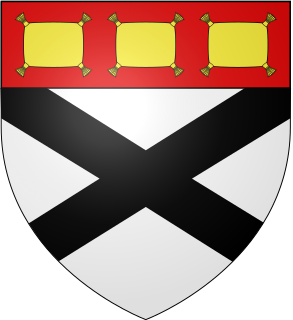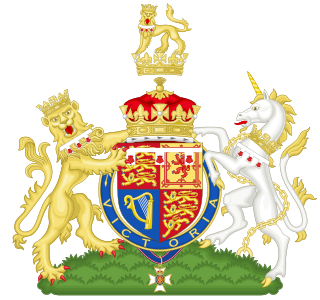The title Viscount Trematon has been created twice, once in the Peerage of Great Britain, and once in the Peerage of the United Kingdom.
- in 1726 as a subsidiary title of the Duke of Cumberland
- in 1917 as a subsidiary title of the Earl of Athlone
The title Viscount Trematon has been created twice, once in the Peerage of Great Britain, and once in the Peerage of the United Kingdom.
Lord is an appellation for a person or deity who has authority, control, or power over others, acting as a master, a chief, or a ruler. The appellation can also denote certain persons who hold a title of the peerage in the United Kingdom, or are entitled to courtesy titles. The collective "Lords" can refer to a group or body of peers.

Duke of Edinburgh, named after the city of Edinburgh, Scotland, is a substantive title that has been created three times for members of the British royal family since 1726. It does not include any territorial landholdings and does not produce any revenue for the title holder.
The Peerage of Ireland consists of those titles of nobility created by the English monarchs in their capacity as Lord or King of Ireland, or later by monarchs of the United Kingdom of Great Britain and Ireland. It is one the five divisions of Peerages in the United Kingdom. The creation of such titles came to an end in the 19th century. The ranks of the Irish peerage are duke, marquess, earl, viscount and baron. As of 2016, there were 135 titles in the Peerage of Ireland extant: two dukedoms, ten marquessates, 43 earldoms, 28 viscountcies, and 52 baronies. The Crown of the United Kingdom of Great Britain and Northern Ireland continues to exercise jurisdiction over the Peerage of Ireland, including those peers whose titles derive from places located in what is now the Republic of Ireland. Article 40.2 of the Constitution of Ireland forbids the state conferring titles of nobility and an Irish citizen may not accept titles of nobility or honour except with the prior approval of the Irish government. This issue has not arisen in respect of the Peerage of Ireland because no creation of titles in it has been made since the constitution came into force.

Duke of Wellington is a title in the Peerage of the United Kingdom. The name derived from Wellington in Somerset, and the title was created in 1814 for Arthur Wellesley, 1st Marquess of Wellington, the Anglo-Irish military commander who is best known for leading the decisive victory with Field Marshal von Blücher over Napoleon's forces at Waterloo in Brabant. Wellesley later served twice as British prime minister.
The Peerage of Scotland is one the five divisions of Peerages in the United Kingdom and for those peers created by the King of Scots before 1707. Following that year's Treaty of Union, the Kingdom of Scots and the Kingdom of England were combined under the name of Great Britain, and a new Peerage of Great Britain was introduced in which subsequent titles were created.
The Peerage of England comprises all peerages created in the Kingdom of England before the Act of Union in 1707. In that year, the Peerages of England and Scotland were replaced by one Peerage of Great Britain. There five Peerages in the United Kingdom in total.
The Peerage of Great Britain comprises all extant peerages created in the Kingdom of Great Britain between the Acts of Union 1707 and the Acts of Union 1800. It replaced the Peerage of England and the Peerage of Scotland, but was itself replaced by the Peerage of the United Kingdom in 1801.
The Peerage of the United Kingdom is one the five Peerages in the United Kingdom. It comprises most peerages created in the United Kingdom of Great Britain and Ireland after the Acts of Union in 1801, when it replaced the Peerage of Great Britain. New peers continued to be created in the Peerage of Ireland until 1898.

Earl of Annandale and Hartfell is a title in the Peerage of Scotland, created in 1661 for James Johnstone.

Earl of Tankerville is a noble title drawn from Tancarville in Normandy. The title has been created three times: twice in the Peerage of England, and once in the Peerage of Great Britain for Charles Bennet, 2nd Baron Ossulston. His father, John Bennett, 1st Baron Ossulston, was the elder brother of Henry Bennett, 1st Earl of Arlington. The family seat was Chillingham Castle in Northumberland.

Earl of March is a title that has been created several times in the Peerage of Scotland and the Peerage of England. The title derived from the "marches" or borderlands between England and either Wales or Scotland, and it was held by several great feudal families which owned lands in those districts. Later, however, the title came to be granted as an honorary dignity, and ceased to carry any associated power in the marches.

Viscount Doneraile is a title that has been created twice in the Peerage of Ireland, both times for members of the St Leger family.

Baron Churchill, of Wychwood in the County of Oxford, is a title in the Peerage of the United Kingdom and held by a branch of the Spencer family. It was created in 1815 for Lord Francis Spencer, younger son of the 4th Duke of Marlborough. He had previously represented Oxfordshire in Parliament.

Baron Londesborough, of Londesborough in the East Riding of the County of York, is a title in the Peerage of the United Kingdom. It was created in 1850 for the diplomat and Whig politician Lord Albert Denison. He was the third son of Henry Conyngham, 1st Marquess Conyngham, and his wife Elizabeth Denison. Born Albert Denison Conyngham, he assumed by royal licence the surname of Denison in lieu of Conyngham in 1849 on inheriting the vast fortune of his maternal uncle William Joseph Denison (1770–1849). Before his elevation to the peerage, Denison had represented Canterbury in Parliament. His eldest son, the second Baron, sat as a Liberal Member of Parliament for Beverley and Scarborough. In 1887 he was created Viscount Raincliffe, of Raincliffe in the North Riding of the County of York, and Earl of Londesborough, in the County of York. These titles were also in the Peerage of the United Kingdom. However, the viscountcy and earldom became extinct on the death of his grandson, the fourth Earl, in 1937.
The hereditary peers form part of the peerage in the United Kingdom. As of November 2021, there are 809 hereditary peers: 30 dukes, 34 marquesses, 191 earls, 111 viscounts, and 443 barons.
The title Viscount Brackley has been created twice for members of the Egerton family; once in the Peerage of England and once in the Peerage of the United Kingdom.

Earl of Dumbarton is a title of Scottish nobility, referring to Dumbarton in the area West Dunbartonshire, Scotland. The title has been created twice, once in the Peerage of Scotland in 1675 and once in the Peerage of the United Kingdom in 2018.

Baron Hylton is a title that has been created twice, once in the Peerage of England and once in the Peerage of the United Kingdom. The first creation came in the Peerage of England 1295 when Robert Hylton was summoned to the Model Parliament as Lord Hylton by writ. His son, Alexander, was called to Parliament in 1332 and 1335, but no further summons were sent for his descendants. Therefore, the title has only been held de jure after the death of the second baron. Indeed, the last baron was Member of Parliament for Carlisle after "inheriting" the title, due to this anomaly. Despite this, the creation is deemed to have fallen into abeyance on the death of the eighteenth baron without male heirs in 1746.

The title of Baron Herbert of Chirbury was created five times, twice in the Peerage of England, twice in the Peerage of Great Britain and once in the Peerage of the United Kingdom.
A subsidiary title is an hereditary title held by a royal or noble person but which is not regularly used to identify that person, due to the concurrent holding of a greater title.